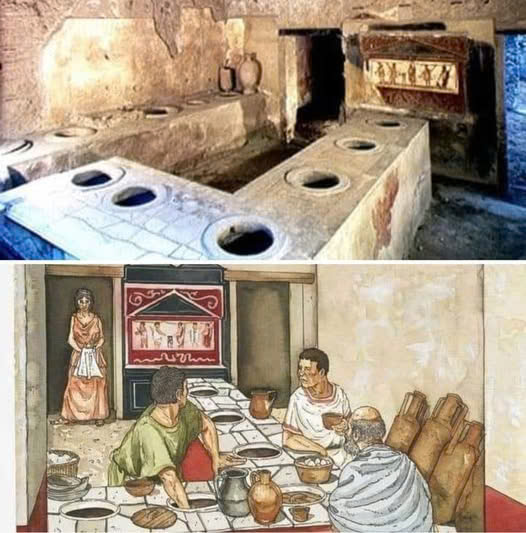Nestled in the shadow of Mount Vesuvius, amid the preserved ruins of ancient Pompeii, lies an archaeological marvel that offers a vivid snapshot of Roman life nearly two thousand years ago. The Thermopolium of Vetutius Placidius, a remarkably well-preserved ancient “fast food” shop, serves not only as a window into the daily habits of Roman citizens but also as a testament to the complex and vibrant urban culture that flourished before the devastating eruption in 79 CE. Through this singular site, we gain an intimate understanding of how food, social interaction, religion, and commerce were intricately woven into the fabric of Roman existence.

To truly appreciate the significance of this thermopolium, one must imagine walking through the lively streets of Pompeii in the 1st century BCE. At that time, there were at least 89 similar establishments spread throughout the city, all designed to serve warm meals to working-class residents, travelers, and anyone lacking a kitchen in their own home. These shops weren’t just for eating; they were lively social centers, buzzing with conversation, laughter, and the clinking of utensils. The thermopolium functioned as a vital part of Roman daily life, offering both sustenance and connection.
The architecture of the Thermopolium of Vetutius Placidius reflects the ingenuity and attention to detail that defined Roman culinary culture. Its most eye-catching feature is the ornately decorated counter, which still stands with its vibrant frescoes depicting animals, food, and mythological scenes. Embedded in this counter are six large dolia—enormous terracotta jars that once held a variety of ready-to-eat foods. Measuring nearly two meters tall, these containers stored staples such as chickpeas, beans, lentils, dried fruits, and likely meats or fish stews, served hot to an ever-rotating clientele. This efficient setup allowed for quick service and constant turnover, much like modern-day food vendors in bustling cities.
However, this establishment was far more than just a place to satisfy hunger. It reveals the layered complexity of Roman life, where even commercial spaces were imbued with religious and cultural significance. Along the back wall of the thermopolium sits a small lararium, or shrine, dedicated to household gods and protective deities, including the Lari, Genius, Mercury, and Dionysus. These spiritual figures were believed to safeguard the business and its patrons, illustrating how Romans merged spirituality with daily routines. The presence of such a shrine in a commercial space demonstrates the holistic approach Romans had toward life—where business, faith, and family were seamlessly intertwined.
One of the most remarkable findings within this thermopolium was the discovery of a hidden stash of 1,385 bronze coins found buried inside one of the dolia. Valued at approximately 585 sesterces, this treasure trove offers rare and invaluable insight into the economic landscape of Pompeii before the eruption. These coins, now preserved in the National Archaeological Museum of Naples, allow historians to better understand the financial transactions, currency circulation, and even the daily earnings of business owners in ancient Rome. Such discoveries elevate our understanding beyond the architectural or culinary and delve into the tangible, lived experiences of people from that time.
Adding a more personal dimension to the site, the thermopolium was connected to the private residence of its owner, Vetutius Placidius. This home included a small but significant garden, where archaeologists believe the owner likely cultivated aromatic herbs such as rosemary, thyme, basil, and mint. The presence of this garden underscores the Roman emphasis on flavor, freshness, and self-sufficiency, even in urban settings. It paints a picture of a culture that prized culinary excellence and appreciated the sensory pleasures of herbs and spices, much like we do today.
This thermopolium stands today not only as a relic of history but also as a bridge between the ancient and modern worlds. It offers a rare, unfiltered look into a society where the rhythms of daily life centered around shared meals, social exchanges, religious observance, and economic enterprise. In many ways, the experiences of Pompeii’s citizens reflect our own modern realities—the need for convenience, the joy of gathering around food, and the integration of personal belief systems into public life.
What makes the Thermopolium of Vetutius Placidius truly extraordinary is how it captures a singular moment frozen in time. When Mount Vesuvius erupted, it encapsulated this bustling eatery in volcanic ash, preserving its layout, contents, and even the last interactions of its patrons. As we explore the ruins today, we are given an opportunity to walk in the footsteps of ancient Romans, to touch the same counters they leaned on, to imagine the aromas that once filled the air, and to connect with the timeless human experiences of hunger, community, and livelihood.
In examining the thermopolium, we are reminded that despite the passage of centuries, our basic needs and desires remain unchanged. The impulse to gather, to share food, to seek comfort and connection in communal spaces transcends time. This site does more than satisfy historical curiosity; it fosters empathy and a profound appreciation for the continuity of human culture.
Through the lens of archaeology, the Thermopolium of Vetutius Placidius speaks not only of loss but also of legacy. It invites us to reflect on how we live today and how future generations may one day view our own cities, eateries, and daily rituals. In its preserved counters and silent dolia, we find voices of the past calling out, reminding us that history is not just about the grand and the monumental—it is also about the ordinary, the personal, and the deeply human.





